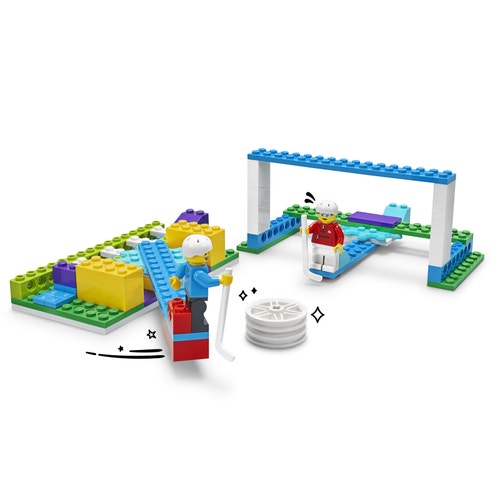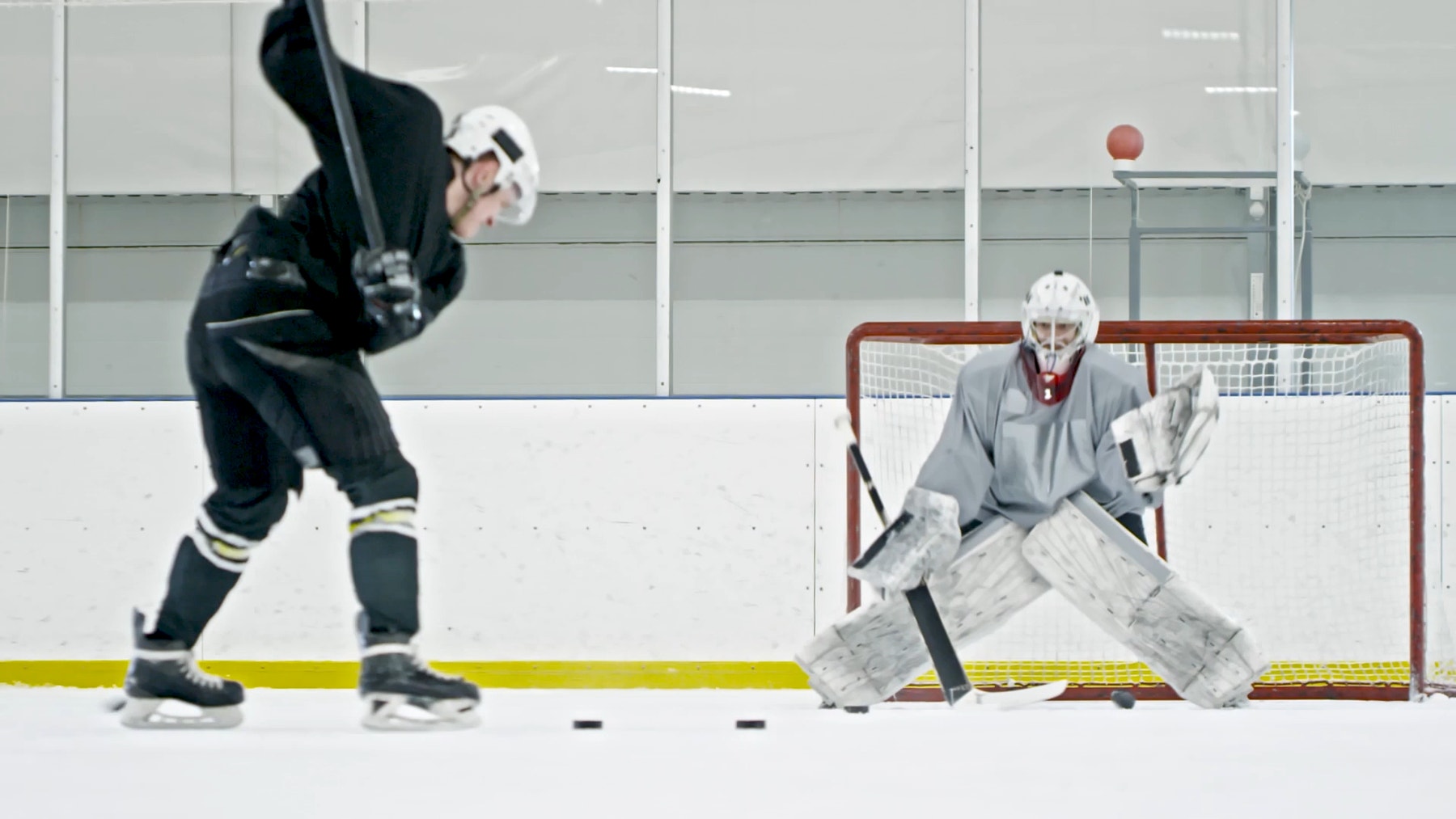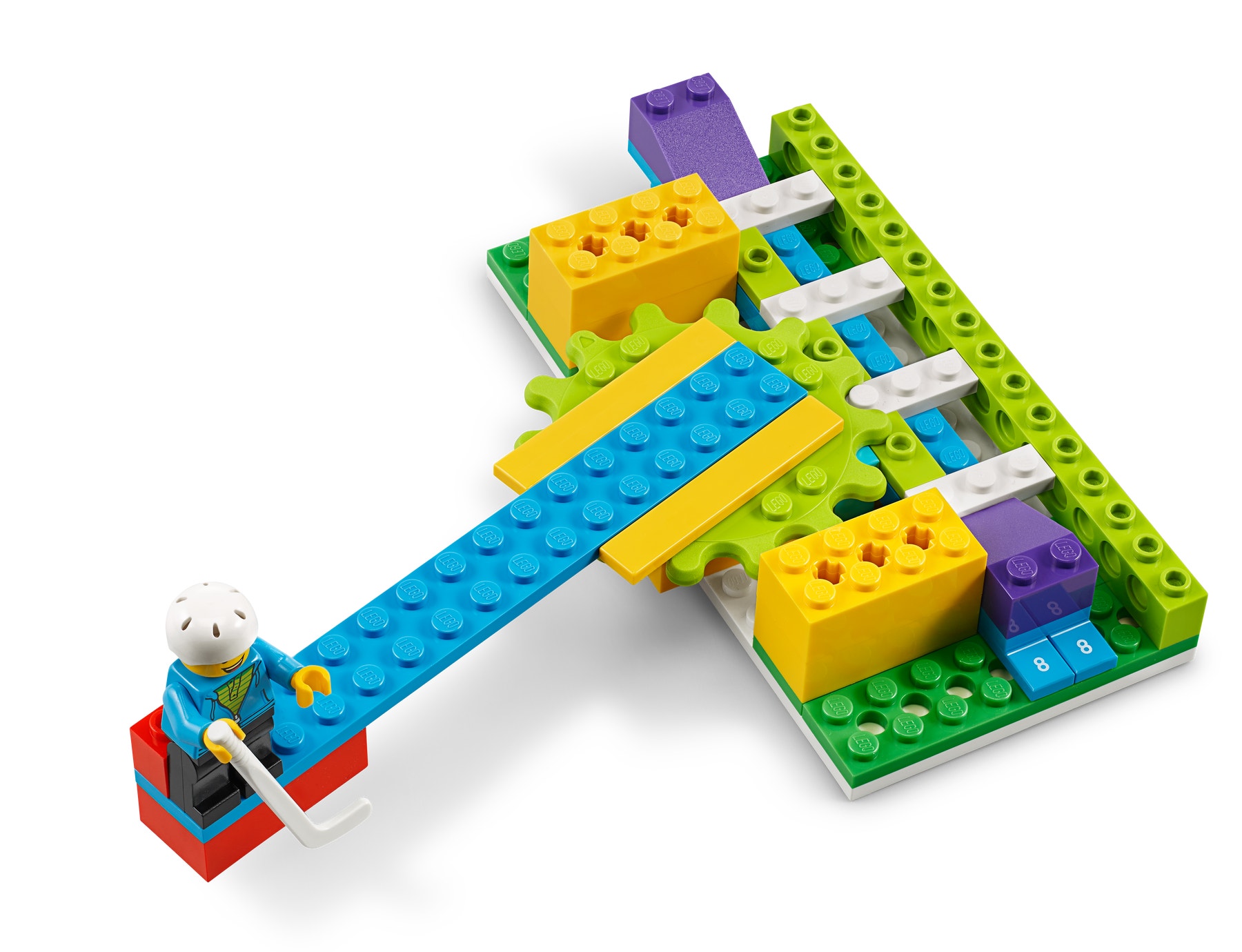Ice Hockey Practice
Build an ice hockey player and goalie! Explore how various push and pull forces help players to make and block penalty shots.

Prepare
- Review the online pupil material. Use a projector to share this material with your pupils during the lesson.
- Make sure that You have covered the relevant concepts (i.e. push and pull) in an earlier lesson.
- Consider the abilities and backgrounds of all your pupils. Differentiate the lesson to make it accessible to everyone. See the Differentiation section below for suggestions.
Engage
(Whole Class, 5 Minutes)
- Watch the pupil video here or access it via the online pupil material.

- Facilitate a discussion about the push and pull forces that are at play in an ice hockey game.
- Introduce the terms puck, player, goalie, making and blocking shots, and force.
- Introduce the concepts of slow, medium, and fast push/pull forces.
- Ask questions like these:
- What is ice hockey?
- How does the puck move? (i.e. How do the players move the puck?)
- How do the players make the puck move at different speeds (i.e. fast and slow)?
- Tell the pupils that they are going to build an ice hockey player and a goal with a goalie.
- Distribute a set to each group.
Explore
(Small Groups, 25 Minutes)
- Have the pupils work in pairs to build the Ice Hockey Practice model. Tell them to take turns, one partner searching for the bricks while the other builds, switching roles after each step has been done.
- You can find building help in the Tips section below.
- When the pupils have finished building, lead them through testing:
- Have the teams place their models about 30 centimetres (12 inches) apart on a smooth surface (i.e. uncarpeted floor or tabletop).
- Tell the pupils to take turns being the player and goalie, switching roles after every 3 shots.
- Practise making and blocking shots with a slow, medium, and fast pull force.
- Each goal is 1 point for the player, have the pupils keep score on their Student Worksheets (Teacher Support – Additional Resources).
- The pupils should test each type of force 3 times for a total of 9 practise shots.
Explain
(Whole Class, 5 Minutes)
- Gather your pupils together to share what they have built.
- Ask questions like these:
- What happens when you push the handle? Why?
- How does the ice hockey player move when you pull the handle? Why?
- What did you notice about how the puck moved with the different types of forces?
- Did you notice anything about the number of goals scored or missed when you used the various types of forces? (Explain that a bigger push makes things speed up or slow down more quickly. A soft or medium push may be all that is needed to make or block a goal.)
Elaborate
(Whole Class, 10 Minutes)
- Ask your pupils to think of ways to improve the game. How could they modify their models to improve their performance? Facilitate a group sharing session.
- Allow 5 minutes for the pupils to disassemble their models, sort the bricks back into the trays and tidy up their workstations.
Evaluate
(Ongoing Throughout the Lesson)
- As they build, encourage the pupils to explore the model's movement and to explain which parts are pushing and pulling.
- Ask guiding questions to encourage them to ‘think aloud’ and explain their thought processes and reasoning in the problem-solving decisions they have made when building their models.
Observation Checklist
- Measure your pupils’ proficiency in describing how various forces affect how a bigger push or pull makes things speed up or slow down.
- Establish a scale that suits your needs, For example:
- Requires additional support
- Can work independently
- Can teach others
Self-Assessment
- Have each pupil choose the brick that they feel best represents their performance.
- Green: I think I can describe what ‘push’ means.
- Blue: I know I can describe what ‘push’ means.
- Purple: I can describe what ‘push’ means, and I can help a friend to understand, too.
Peer Feedback
- In their small groups, have the pupils discuss their experiences working as a group.
- Encourage them to use statements like these:
- I liked it when you…
- I'd like to hear more about when you…

Tips
Model Tips
- This is a challenging model that will take some teams up to 20 minutes to build. At the end of 20 minutes, they should've at least finished building the player. it is best to stop the pupils building at the 20-minute mark and ask them to practice moving the puck. If some groups have not finished building the goalie, they can just place 2 bricks on the table and shoot between them.
- The gear rack on the player model is not attached. it is designed to slide on the smooth blue number bricks and stay ‘locked’ in place by the green brick and the 2x4 yellow bricks. It is held down by the gear.

Differentiation
Simplify this lesson by:
- Having the pupils stop building after they have finished the hockey puck pusher; they can use their hands or other markers as a goal
Increase the difficulty by:
- Having the pupils record 1 point for each slow, medium, or fast pull goal scored
- Challenging your pupils to find a way to swap the blue gear for the green gear in the player model and then test various forces by comparing the 2 gears
- Asking each team to design their own ice hockey rink
Extensions
Maths Extension (Note: This will require additional time.)
To incorporate the development of maths skills, have your pupils play an ice hockey game and stop when they reach a score of +20 or -20. These are the rules:
- Player: Each scored goal is +1, each lost goal is -1
- Goalie: Each blocked goal is +1, each scored goal is -1
- They should keep score on their Student Worksheets; or use bricks to keep score, giving or taking away 1 brick for each point scored or lost.
ACMNA015
Represent and solve simple addition and subtraction problems using a range of strategies including counting on, partitioning and rearranging parts
1:1 Hybrid Learning
Download the Personal Learning Kit lesson plan from the hybrid learning resources.
Teacher Support
The pupils will:
- Explore the effects of different strengths of push and pull forces on the motion of an object
- See how a rack and pinion mechanism works to convert a linear-pull into a rotational push
- LEGO® Education BricQ Motion Essential Sets (one for every two pupils)
ACSSU018
Everyday materials can be physically changed in a variety of ways
ACSIS025
Participate in guided investigations to explore and answer questions
ACMNA015
Represent and solve simple addition and subtraction problems using a range of strategies including counting on, partitioning and rearranging parts




